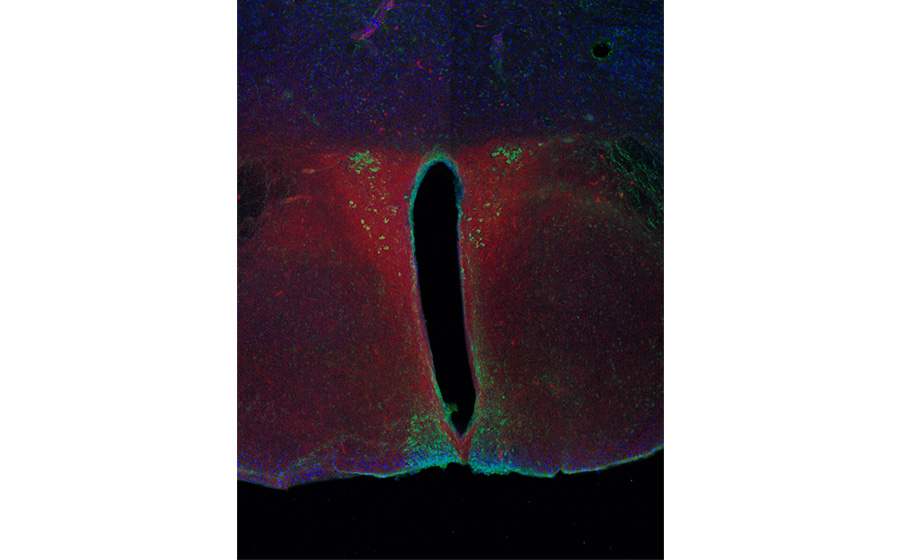
Singing the body electric, one cell at a time
Body Clock
You measure time. You are both the keeper and record, the extraordinary consequence of synchronies in series, a symphony of coordinated rhythms and loops: proteins polymerize, ions flow, spindles align, cells mitose, hormones surge, vesicles fuse, alveoli inflate, heart beats, neurons fire, gait steps, fingers tap, wounds heal, hair grays, telomeres shorten, perceptions prime, behaviors habituate, and memories form and fade. The pace of life means you rarely attend to its cycles. Periodically your origins interrupt; you are humbled by jet lag, stubble, menstruation, death. As an amalgamation of chemical reactions, you should not be happening. Every drawn breath is a laugh in the face of time, endowed by time’s lifelong trickster: the enzyme. A few degrees too many, they denature and you stop. Time is the reason you sweat.
As time-keepers, as with most things, we are most reliable unconscious. Even in the absence of external cues, the zeitgebers, our internal rhythm, oscillates around twenty-four hours and eleven minutes. The orchestration or precision timing required to traverse traffic, shake a hand, or utter a word lies below our threshold of awareness, in the order of milliseconds. And milliseconds matter. In conditions such as Parkinson’s disease, schizophrenia, and autism, where time-perception is perturbed, to move is to stammer. Stuttering eyeblinks syncopate facial and verbal micro-expressions, opaquing subtle social cues. Life is rendered a series of missed beats.
For the arachnophobe, eternity is a spider. Because our conscious perception of time is a construct that relies on memory, it is, like memory, malleable””vulnerable to distortion by emotion, attention, pharmacology, temperature, and sweat. Stimulants speed it up. Depressants and anesthetics slow it down, as do fear, sadness, and pain. Though our happiest instants may be experienced as relatively fleeting, we attribute, in retrospect, as if by some sanity-saving mechanism, far more time to them than perceived eons, lingering longer on vacations, love affairs, and first experiences than traffic jams, bladder states, or bad jokes. The valence of tedium rarely smarts. Amongst a lifetime of tears, the boredom-induced rank low.
Models for the subjective perception of time, or interval timing, propose an internal pacemaker that produces time units which accumulate, ultimately to be compared to stored reference time durations. What and where is this pacemaker? These reference times? Is it the basal ganglia spiny neurons, with their repetitive firing rate? Maybe. Or the anterior insular cortex, which seems to integrate information of all things self? Lesion and imaging studies present many possible candidates for the location of pacemakers and accumulators. The finding, or its lack, of a single time-sense organ suggests that time is perceived over distributed regions, perhaps in a number of ways.
The Prepared Mind
What time should I set the alarm? Subway or cab? Can I see myself living in this apartment or city? Prospection, or future-thinking, includes simulation, prediction, intention, and planning. Reliant on memory, prospection is also shaded by emotion. Depressed people have goals and place importance on them, but they are less positive about their occurrence, feel they have less control over them, and forebode negative events as more likely to happen. Life appears hopeless. The nondepressed are overoptimistic, consistently underestimating the time required to complete tax forms, assemble furniture, and build buildings. Next time you are late, blame it on the planning fallacy. Affective forecasting is our ability to anticipate the emotional impact of a future event. We are good at predicting quality (positive or negative), but not quantity (how positive or negative), underestimating the benefits of positive interactions with strangers and the pain of being socially excluded or mildly insulted.
Can goldfish be impulsive? Bacteria patient? Do adolescent lobsters molt recklessly? Do self-sabotaging starlings procrastinate their migration? Because we can conceive of a future, we can plan for and anticipate one, foregoing immediate rewards for ultimate payoffs. Delayed gratification is context dependent and follows a delay discounting rule: the larger the reward, the longer we can wait. Imagining a positive future self is more difficult for the depressed and stressed. Patience and tenacity are blunted. Projects and diets are readily abandoned. The focal length of an addict’s horizon is limited to the next hit.

The Natural Order
Time is tied to metaphor, bound in space. We move through time. It flows past us. The sun rises in the east, the moon waxes and wanes, but the way we know night follows day, death follows birth, and more crucially, lunch follows breakfast””the formation of our spatiotemporal maps””is less influenced by the geometry of the heavens and more by the language we speak. Time cells and place cells are neighbors in the brain, both residing in the hippocampus, the brain structure essential for memory. Charting time with space is universal across languages, but the direction we write dictates our mental timeline: English is left to right, and Mandarin can be both horizontal and vertical. For larger epochs, all cultures think dorsal-sagittally, looking ahead to the future with the past behind them. All cultures apart from one: Aymara speakers see the future as behind them, because the future is unknown. Elderly Aymara people refuse to talk about the future on the grounds that little or nothing sensible can be said about it. They’re right. The future is imagined, hypothetical. But hypotheticals exist in all tenses. Our mind is a constellation of conditionals and counterfactuals. If time is a line, then truth is a vector.
Imagining the future is remembering the past. The processes are symmetrical, engage the same brain structures, and develop in parallel. An amnesiac fails at both. We deconstruct our semantic memories (what we know about the world) and our episodic memories (what has happened to us) and recombine them with intention. We remember what hasn’t happened. To conceive of who we were, are, and will be is essential to the construction and continuation of the self. We can mentally time travel abstractly””chronosthesia””to think of a past and a future, but it is our autonoetic awareness, our synthesis of personal memory and intention, that enables us to not only conceive of the future but to project ourselves into it, with feeling. To maintain selfhood, we overlap considerably with our near-future iterations, but the further we project in time, the more tenuous this imaginary string of selves becomes, until it threatens to be severed, such that we appear other. Order follows time’s arrow into chaos. But humans love to order. As molecules sequentially arrange themselves into structures of increasing complexity, we temporally arrange perceptions and movements into gesture, language into narrative. Life defies decay. Narrative defies forgetting. Both continue to defy erasure.
In the Rubin talk The Science of Nostalgia, Shezad Dawood was joined by neuroscientist Leah Kelly to further explore nonlinear narratives and the negative and positive influences of nostalgia.
About the Contributor
Leah Kelly is a neuroscientist at Rockefeller University. She uses electrophysiology, tracing, and imaging to elucidate how neurons communicate with the rest of the body to regulate appetite and metabolism. In 2014 she co-curated the Impakt Festival in the Netherlands. Her essay “Sense of Self” appears in Experience: Culture, Cognition, and the Common Sense, published by MIT in 2016.


